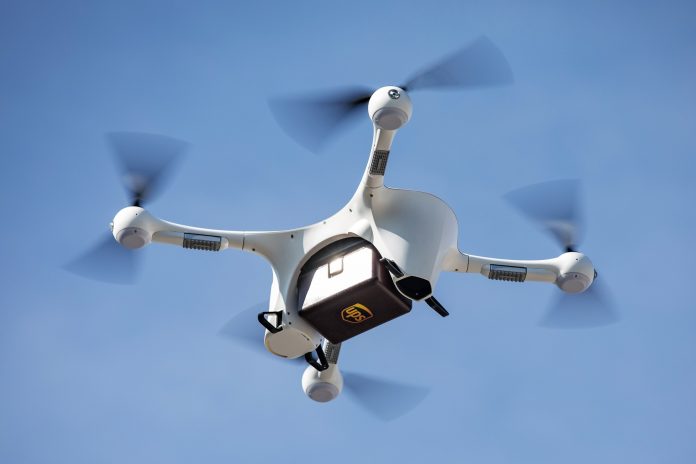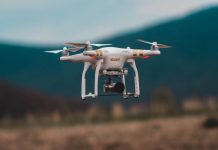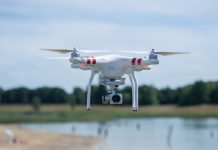This article is written by Aditya Narayan Joshi pursuing BA.LLB (Hons.) This research focuses on the developments of Drone Laws in India and their comparison with laws prevailing in countries like the UK and USA.
Table of Contents
Introduction
Advancement of technology follows an exponential growth curve. Any modern development begins with a few ground-breaking experiments that create popular interest which may or may not see mainstream acceptance. Sluggish growth with incremental improvements is the norm, until an inflexion point, either caused by core technology innovation or the discovery of new applications, results in exponential growth in adoption.
We may be in a new era of technological development, from the Mobile to electric cars. The field of drones or unmanned aerial vehicles (UAVs) is no different. In 1849, the very first attempts to develop a contraction that could travel alone were published, When the Austrians invaded the city of Venice with explosive-laden balloons. While we are searching for a more recent concept, the United States Army developed the first pilotless aircraft at the end of World War I: machines dubbed ‘Kettering Bugs’ which were supposed to function as airborne torpedoes using gyroscopic controls to strike enemy lines. The first radio-controlled (RC) aircraft was developed independently by the US and British armies around the 1930s. Development and use of such drones continued to be mainly for military warfare. In other nations, the drone space in India catches up with that and gains considerable momentum. The Indian UAV market is expected to rise in revenue at a CAGR of 18 per cent 4 throughout 2017–23, according to 6Wresearch. While the long-range UAV segment will continue to drive these numbers, medium to mini UAVs will also be ready for healthy growth. Statistics issued by the Stockholm International Peace Research Institute (SIPRI) show that India tops the list of drone-importing nations with 22.5 percent of the world’s UAV imports. Once, these are figures mainly for combat uses and so do commercial drones. Studies by BIS Research say that by 2021, demand for commercial drone use will cumulatively surpass the military industry by around 900 million US dollars in 2021.

Drone Laws in India
India’s Civil Aviation declared on August 27, 2018, the country’s first Civil Aviation Specifications (CAR) for drones that took effect as of December 1, 2018.
1. Is owning a drone legal in India
That is it. Yet carrying a drone without trying to travel means nothing. So if you want to fly the drone then you must register your drone with the respective authority that was later defined according to the Drone Laws in India.
2. What are the Categories of Drones in India
Nano: 250 grams or less (.55 pounds)
Micro: Between 250 grams (.55 pounds) and 2 kg (4.4 pounds)
Small: Between 2 kg (4.4 pounds) and 25 kg (55 pounds)
Medium: 25 kg (55 lbs) to 150 kg (330 lbs)
Large: > 150 kg (33 pounds)
Registration for category Nano is not required.
3. Requirements that Drone must have in order to qualify for flight in India
Also deserving of mention is the Indian Govt. Has unique criteria concerning the types of characteristics that a drone will operate in India (excluding those in the group Nano). Those compulsory requirements include:
- GPS-GPS
- Back to the (RTH)
- Arm Against accident
- Pot Version
- A flight controller with the capability to log the flight data
- RF-ID and Flight / No Take-off Permit (NPNT)
Civil Aviation Minister Suresh Prabhu said, “Today we are starting an exciting new chapter in India’s aviation history by enabling drones to be used commercially. I am sure a number of interesting new technologies will arise that will move India’s economy forward. Our ambitious rules would nurture a huge drone industry Built in India. Licensing and registering a flight session for your drone is now made easy by the Civil Aviation Ministry, Govt. In India, Owners and pilots will need to register, and each flight will require permission. Users would need to request for drone approval via the website and wireless licenses will be granted automatically by an automated procedure. The regulatory authority for Drone in India is Civil Aviation Directorate-General, Government of India
As of 1 December 2018, operating a Drone or Remotely Piloted Aircraft System (RPAS) became legal throughout India. The Civil Aviation Ministry finally finalized the national drone policy and set parameters for drone flights – including flying height.
The regulatory authority for Drone in India is Civil Aviation Directorate-General, Government of India
No permission, no take-off policy
Drone pilots may seek permission to fly with a smartphone device or from the Digital Sky website before every single flight in reach. That handles the request automatically, and the program automatically grants or refuses it. India names the program “No Authorisation, No Take-off” (NPNT). If a drone pilot tries to fly without Digital Sky Platform permission, then he or she simply won’t be able to take off. All drone operators must register their drone and demand permission to fly through India’s Digital Sky Platform for each flight.
Policies welcoming Drones in 2020
The Year 2019 kept a number of players in the Indian drone industry occupied with the challenge of reaching new technological requirements to conform to the regulatory structure for drone operations laid down by the Indian government as of December 1, 2018. The government appears determined to overcome the hurdles to enforcing the regulatory framework by 2020. The legislative structure for drones was released by the Civil Aviation Directorate-General (“DGCA”) on 27 August 2018 by way of Civil Aviation Specifications (CAR), Section 3 – Air Transport Sequence X, Portion I, Question I (“Drone Regulations”) for the approval and control of drone operations for civil usage in India. The Drone Ecosystem Policy Roadmap was therefore published by the Department of Civil Aviation on 15 January 2019 on behalf of the Task Force on the basis of recommendations1.1 following that the authorities launched several new initiatives aimed at capacity-building of the drone ecosystem in 2019, a trend which will continue in 2020. This article brings you the numerous innovations relevant to the drone environment in India which could be of interest to organizations doing drone-based business in India or looking to do so.
Invitations by DGCA for expressions to perform experimental BVLOS operations
On 13 May 2019, the DGCA invited the consortia to demonstrate its concern and experiment with remotely piloted aircraft or drones in Indian airspace outside its eyesight (“BVLOS”) operations. In 2019, the Ministry of Civil Aviation (‘MoCA’) also released the National Combat Rogue Drone Guidelines (‘NCRD Guidelines’) aimed at solving potential law and order and national security problems expected as a consequence of uncontrolled and unrestricted drone operations. The NCRD Directives aim to define specific counter-hypocritical drone interventions and guidance, to be used to cope efficiently with the respective risks.
On 6 January 2020, Shri Rajnath Singh, Indian Minister of Defence, unveiled www.modnoc.ncog.gov.in a platform for aerial surveillance, with DGCA’s end-of-life sanction, No Objection Certificate (NOC). Different vendors will use the portal to search for NOC from the MD by government, public sector companies or autonomous bodies. This initiative will allow the MoD to reduce the time it takes for NOCs to be issued and to ensure that aerial surveys and/or remote sensing surveys are quickly removed.
A glimpse of Drone Laws in the UK
Drones are classified in three categories: A, B and C – with the lightest and least complex category A, and the highest category C – based on their weight, technical complexity, and operative environment.
Typically drones weigh up to 7 kg in category A. Drones in this category do not need certification, but pilots must demonstrate their skills to carry them out. Operations in VLOS must be performed. VLOS operations are standard operational limits not to be more than 500 meters horizontally or 400 meters above him or her. Typically Category B drones weigh between 7 and 150 kg. Drones in this group need aviation and operating authorizations as well as proof that they are pilot competence. The procedure will take place in regions VLOS and Extended-VLOS. Category C drones also weigh seven to 150 kg but are very complex to operate technically and are used in complex operating environments. Drones receive a comprehensive review under this group and have stringent permissions. The pilot and operational requirements are identical to those of Category B drones in that they are allowed to work in airspaces above VLOS and are complicated. While the fully autonomous operation of a UAS is not authorized, certain portions of operations may be conducted without human interference with prior authorization from authorities.
A glimpse of Drone Laws in the USA
Regulations in the USA are broadly divided into ‘Fly for Fun’ and ‘Fly for Work. The drone must be registered in the ‘Fly for Fun’ category if it weighs more than 249.48 grams and weight is not to exceed 24.95 kg. This will work 8.05 km from airports and will alert the airport and air traffic control tower whether operations are to be performed within this radius. Also in the group ‘Fly for Work’ the weight of the drone must be less than 24.95 kilograms. All drones weighing more than 250 grams that are used for this category must be registered. They can only travel between VLOS and 400-feet AGL height during the daytime. The operator must be at least 16 years old for the designation ‘Flight for Employment,’ complete an initial Federal Aviation Administration ( FAA) aeronautical skills exam, and must be approved by the Transportation Safety Administration. The FAA approves flights on autonomous drones albeit under other restrictions.
What does India need to do next?
(What Indian Ministries need to work upon to make Indian drone laws as mature as of U.K‘s and U.S.A’s) Applications for industrial drones are on the rise across industries. While the usage of drones in the commercial sector increases, many industry estimates suggest that by 2021 the Indian demand for commercial drones will hit $885.7 million. India became one of the largest drone-importing nations, accounting for 22.5 percent of UAV imports worldwide.
Israel and the United States have emerged as the biggest drone exporters to India, with an emphasis on increasing their range of equipped drones. In 2018 the Indian government authorised Israel’s procurement of Heron TP missile-armed drones. The United States will export the General Atomics MQ-9 Guardian/Predator-B long-range unmanned combat aerial vehicle (UCAV) to India, making it one of the most significant defence sales between the United States and India. The sale of drones with military applications has become an important part of bilateral defence ties between India and the United States, and both countries operate under the Defence Technology and Trade Initiative. Breaking away from the dominant narrative that focuses on India-U.S. collaboration on drones for military purposes, this Article aims to underscore that India and the United States have a unique opportunity to partner on commercial drones. Over the coming years, drones will become an integral element to a better standard of living. India and the United States. Should partner to harness the benefits of commercial drones by leveraging the technological prowess and culture of innovation that exist in both countries. In almost the same manner as the rules of Section 107 of the Federal Aviation Administration (FAA) encouraged the proliferation of commercial drone operations throughout the U.S., the Civil Aviation Directorate (DGCA) throughout India requires to take proactive measures to liberate the local commercial drone industries from the burden of legislation as curb the sector to flourish.
It is critical that the DGCA undertakes policies that ensure both drone protection and security, but also slowly promotes operations beyond the current Beyond Visible Line of Sight (BVLOS) cap of 400 feet. India would need to fine-tune its legislative policy on drone export legislation to international requirements. The number of drones in the sky and the amount of breaches – unintentional or illegal – are both prompting Indian and American companies to work on counter-drone technologies to keep out unauthorized drones. In the commercial field, drone technology has the ability to have enormous effect in terms of work growth, productivity increase, and performance. It is apparent that the growth of the commercial drone market should take place in near collaboration with the Government of India. Experts note, however, that strict regulations will stifle the thriving commercial drones market. There has to be a pragmatic approach where the government should protect the privacy of a person, track drones that might threaten national security, while at the same time promote policies that enable the commercial drone industry to thrive. Another significant point to note is that while much of the recent drone controversy has centred on the state’s usage of drones for surveillance and military purposes, the use of drones by and for civil society is worthy of consideration. There is a vital need for policy enabling and handholding between India and the United States for any underlying opportunity in the case of the commercial drone market in India.
Talking about U.K’s law Foreign Operators are permitted to fly drones with special privacy guidelines and permissions, India’s drone laws are still struggling to grant easy permissions to foreign entities to fly their UAVs in the country. This acts as a solid Hindrance in commercial flying of drones in India which further may result in foreign companies diverting their business routes to other countries. If you’re an international drone pilot who decides to do research in the U.K. (i.e., you want to do commercial drone work in the United Kingdom), the CAA will normally be able to grant permissions to foreign operators on the grounds that you are able to meet the same basic safety requirements as those required by UK operators. For this India needs to make special privacy favourable guidelines for foreign entities which allow many opportunities for the companies as well as the country regarding Drone operations. Commercial drone operations are smoother in both countries as compared to India’s. Well, that’s not the case with India considering India’s early stage in the development of drone laws there is a long journey to be taken to formalize more lucid and concrete laws in this domain.
Conclusion
In conclusion, it is important to emphasize that although much of the recent drone debate has focused on the state’s use of drones for surveillance and military purposes, the use of drones by and for civil society is worthy of attention. There is a vital need for policy enabling and handholding between India and the United States for any underlying opportunity in the case of the commercial drone market in India. There needs to be political agreement and cooperation between the Ministry of Defence, the Ministry of Home Affairs, the Ministry of Commerce and Industry, the Ministry of Civil Aviation, for a smooth launch and development of the commercial drone industry in India, Industry and International Trade Promotion Ministry, and Niti Ayog among others. In addition, major policy funding needs to be made in drone education – educating operators, capacity building for drone production, drone identification and monitoring, remote pilot qualification, and other qualified drone services. It is time for India to partner with the United States on the growth of its commercial drone market, establishing and improving the regulatory environment so that commercial drones can be used efficiently and securely, as well as for application scalability.
References
- Ministry of Civil Aviation
- Digital sky Portal
- Federal Aviation Authority
- FAADroneZone portal
- Civil Aviation Authority of the UK (CAA) Crilly, R. (20 June 2011). Drones first used in 1848. The Telegraph. Retrieved from https://www.telegraph.co.uk/news/worldnews/northamerica/8586782/Drones-first-used-in-1848.html (last accessed on 20 July 2018)
- Leu, C. The secret history of World War II-era drones. Wired. Retrieved from https://www.wired.com/2015/12/the-secret-history-of-world-war-ii-era-drones/ (last accessed on 20 July 2018)
- Bagla, G. (4 May 2015). India leads in the import of unmanned aerial vehicles. Blog. Retrieved from http://www.theindiaexpert.com/tag/sipri (last accessed on 20 July 2018)
- Aircraft Rules,1937
- Guidelines for Drone Policy 2.0
- The Air Navigation (Amendment) Order 2018
- The American Security Drone Act of 2019
- Meenal Dhande, “The current scenario of global drone regulations and laws,”
- Geospatial World, November 19, 2016, https://www.geospatialworld.net article/present-global-drone-regulations-laws/
LawSikho has created a telegram group for exchanging legal knowledge, referrals and various opportunities. You can click on this link and join:










